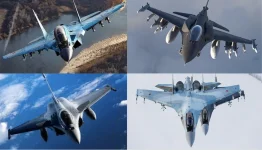- Views: 2K
- Replies: 14
For decades, the Indian Armed Forces have displayed unwavering resolve and resourcefulness in battle. However, the integration of air power with armoured operations faced a significant hurdle: a shortage of dedicated attack helicopters.
Despite the capabilities of the Mi-35 Hinds and AH-64E Apaches, their limited numbers—approximately 20 combined—fell short of India's extensive operational demands, especially along its disputed borders. Now, this is changing with a significant expansion of India's attack helicopter fleet.
Historically, India relied on utility helicopters adapted for combat roles. The HAL Lancer, a modified Cheetah helicopter, served as a temporary solution, primarily suited for counter-insurgency rather than the intense requirements of modern warfare. Its limited agility, firepower, and survivability were insufficient for supporting armoured assaults against a well-equipped adversary.
The introduction of the HAL Rudra, a weaponized variant of the Advanced Light Helicopter (ALH) Dhruv, marked a turning point. Equipped with a 20mm turret gun, 70mm rockets, and anti-tank guided missiles (ATGMs) like the Helina, the Rudra demonstrated the potential of dedicated attack helicopters in providing close air support and armed escort, particularly in challenging terrains such as Kashmir and the Northeast. The Rudra replaced the Lancer.
However, the HAL Light Combat Helicopter (LCH), named Prachand (meaning "fierce" in Sanskrit), represents a true leap forward. With plans for approximately 150 LCH units (90 for the Army and over 60 for the Air Force), India is set to transform its combined-arms operations.
This isn't just about increasing numbers; it's about deploying a platform specifically designed for India's unique operational environment, especially the high-altitude regions along the Chinese border in Ladakh and Arunachal Pradesh.
The LCH is engineered for the Himalayas. Its operational ceiling of 6,500 meters (over 21,000 feet) surpasses most attack helicopters globally, including the U.S. Apache and China's Z-10. This high-altitude capability, demonstrated by landings in Siachen, makes it ideally suited to support armoured units navigating the challenging terrain and thin air of the Line of Actual Control (LAC).
The LCHs, with their 20mm cannons and rocket pods, could provide crucial support to T-90 tanks operating in mountain passes, engaging Chinese infantry, light armour, and fortifications. The integration of the indigenous Helina ATGM, with a range exceeding 7 km, would further enhance this synergy, enabling the disruption of enemy formations.
However, the LCH's survivability is paramount. The Rudra and ALH Mk-3 are equipped with advanced Self-Protection Suites (SPS), including radar warning receivers, missile approach warning systems, and chaff/flare dispensers. To be effective against PLAAF air defence systems and Z-10 helicopters, the LCH will require an equally capable, if not more advanced, SPS, incorporating next-generation jammers and laser warning systems.
The full potential of the LCH depends on the seamless integration of the Helina ATGM. While the Rudra has test-fired this missile, deploying the LCH with ATGMs remains a priority. Expediting this process is crucial to provide India's Integrated Battle Groups (IBGs) with an organic, responsive strike capability, reducing reliance on distant air force assets.
This expansion signifies a strategic shift. With a total of over 300 attack helicopters in the pipeline, including Mi-35s, Apaches, Rudras, and LCHs, India is moving beyond piecemeal solutions towards a comprehensive rotary-wing doctrine.
On the western front, Apaches and Rudras can support mechanized advances across the plains against Pakistan. In the east, the LCH's high-altitude capability can deter Chinese aggression, working alongside artillery and drones in a multi-domain operational framework. The era of armoured columns advancing without dedicated air support is coming to an end.



